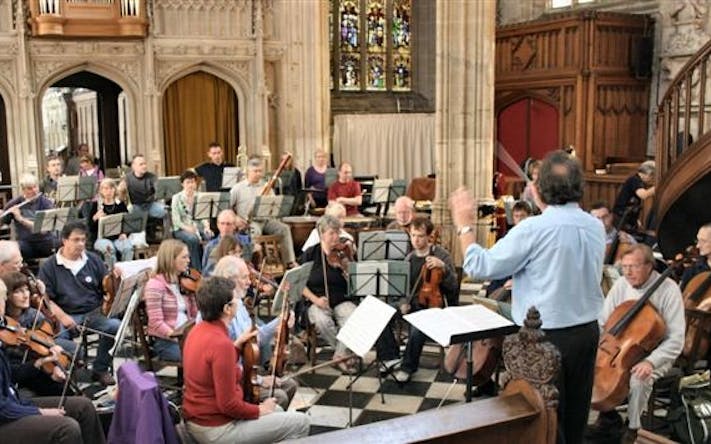The Oxford Sinfonia was at St Mary the Virgin Church on Saturday night for one of their four concerts per year, this time playing a programme of German music.
For the Beethoven Violin Concerto in D major, our orchestra numbered 35, of whom c. 25 were women - the second time recently in Oxford I've encountered an orchestra comprising a majority of female players - a very welcome circumstance. Stephen Ellery, Associate with the English Concert Orchestra, conducted sans baton or podium from the chequered-tile floor of the chancel, while soloist Dominic Moore in a navy-blue shirt played from a rather cramped space 'twixt violins and the front pews.
The unusual opening of four quiet drum-taps, then a woodwind phrase led to the entry of the soloist, striking out boldly. Later we reached the emotional heart of the movement, where the rhapsodizing of soloist and strings is kept under restraint by horns, bassoons and then Haydnesque trumpets in turn. These instruments were the most impressive elements of the orchestra, to my ear. The solo violin then ran into a long ascent, magically sotto voce. Mr Moore told me afterwards that his first cadenza here, together with those elsewhere, was transcribed by himself and all are from the hand of the composer himself.
The slow movement is marked as larghetto, ie in between slower largo and faster andante. Here Messrs Ellery and Moore took it at largo pace, if that, and the movement never got off the ground, remaining sluggish throughout. Much of it sounded almost like spontaneous improvisation from the violinist, whereas the structure of the music is organised according to a very strict plan, with four stages to the treatment of the theme. The fact of the whole concerto coming in at 20% over standard time is largely owing to the glacial tempo set here.
The final rondo bore an outdoor flavour, another long cadenza leading to the dramatic ending - two thumping chords from the full orchestra.
After the interval we heard Schumann's Symphony No. 3, from 1850, the last of his symphonies, and inspired by visits with his wife Clara to Cologne and the Rhine country. The first movement unrolled in familiar Beethovenesque manner, with virile chords and the timpanist in constant action. The second movement is more interesting to my ear, conjuring up landscape by suggestion, not in a programmatic manner like, say, Beethoven's Pastoral Symphony. There was a pleasing depth to the sound here, provided notably by the bassoon and the horns, although as in his 2nd Symphony, heard at the Sheldonian in July, Schumann proceeds via simple, sequential repetition in place of thematic sleight of hand. Variation and even decorative embellishment are largely absent.
The fourth, majestic movement derives from Schumann's having attended in Cologne Cathedral the installation of its archbishop as cardinal. Here the three trombones really shone with a simple chorale that put me in mind of Wagner, who by this date had already written his Lohengrin. Mr Ellery at one moment really went to town here in his efforts to drag the notes out of his 1st violins, apparently pummelling a punch-bag in a boxing gym down the Old Kent Road.
It's shocking to think that the man who wrote this solemn, inspiring anthem was within three years confined to a psychiatric asylum from which he never emerged.




